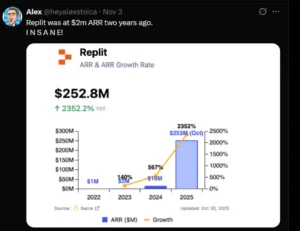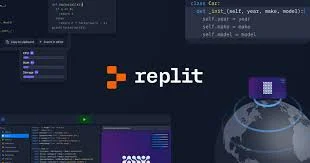I came across a tweet recently showing Replit’s growth graph, a near-vertical curve that instantly caught my attention. It wasn’t just another tech success story; it was a lesson in how smart product design and timing can power explosive scale. That graph represented years of deliberate choices: lowering barriers to entry, building community momentum, and layering AI in a way that actually mattered.

As I dug deeper into Replit’s story, it became clear that their rise wasn’t luck. It was a playbook that other startups (especially those chasing sustainable growth) could learn from.
From a Browser Tool to an AI Platform
Replit started as a browser-based IDE built on a simple idea: make coding as easy as opening a webpage. No downloads, no installations, no setup headaches. That low-friction model made it a natural fit for students, educators, and developers testing quick ideas. Each small decision reinforced the same goal of keeping users inside the product.
Then came the real inflection. In 2024, Replit moved beyond being just a coding platform and integrated AI directly into the creative process. Ghostwriter, its AI assistant, and later, AI agents that could generate entire applications, turned Replit into a coding ecosystem, a place where development and automation converged.
By 2025, the company had raised $250 million at a $3 billion valuation. But what stood out wasn’t just the funding; it was how they earned it, by scaling through community, utility, and intelligence.
The Anatomy of Replit’s Strategy
After looking at that growth curve, I realised the company’s success rests on a few principles that can be imitated, not copied exactly, but adapted intelligently.
1. Start With Zero Friction
Replit’s onboarding takes seconds. The product removes every possible hurdle between curiosity and creation. That simplicity converts browsers into users and users into regulars. For other startups, the question is: how fast can someone experience the core value of your product?
2. Let the Community Market the Product
Replit’s users build apps, share code, and teach others. Every shared project is a marketing channel in disguise. A strong community builds itself when participation feels rewarding and visible.
3. Add AI as a Multiplier, Not a Decoration
Replit didn’t bolt on AI for hype; instead, it embedded AI into real workflows. Ghostwriter made coding faster, and AI agents made app creation easier. The key lesson is to integrate AI where it directly amplifies what users already do.
4. Mix Free Access With Smart Monetisation
Replit balances a massive free tier with paid plans for advanced compute and AI use. The hybrid model converts curiosity into revenue without breaking accessibility. It’s a strategy that lets the product grow before it monetises heavily.
5. Grow Through Education
Replit found one of the most sustainable growth channels: classrooms. Teachers introduced it to entire cohorts of students, turning education into a distribution. For any tech company, an institutional foothold is often more powerful than advertising.
6. Move Upmarket Once the Base Is Solid
Only after building trust with individuals did Replit roll out enterprise-grade features, private workspaces, team billing, and security tools. Growth first, enterprise later.
Lessons for Other Startups
Startups often chase viral growth or complex AI products before perfecting the basics. Replit’s story shows that scaling sustainably starts with simplicity. Its core loop (fast access, visible progress, and community validation) is the foundation. Everything else, including AI, came later to multiply what already worked.
Here’s how others can follow the path:
Create a straightforward product that provides immediate value.
Foster a community where sharing and feedback are natural.
Introduce AI where it reduces friction or boosts creativity.
Use hybrid pricing to capture both reach and revenue.
Find a niche distribution channel (such as education or creators) to spread organically.
Why It Works
Replit’s growth was forged at the intersection of two major shifts: the demand for accessible coding tools and the rise of practical AI. It met both needs with precision. The product was both easy and empowering to use. That combination, visible in that steep growth graph I saw on X, is what most startups miss.
Final Thought
Replit’s growth curve tells a bigger story than numbers can show. It’s a model of intentional simplicity and community-driven innovation. The company didn’t scale by spending heavily on marketing or chasing hype; it scaled by removing friction and delivering consistent value.
For founders, that graph is a challenge to build products that people return to, not because they’re told to, but because they want to.









